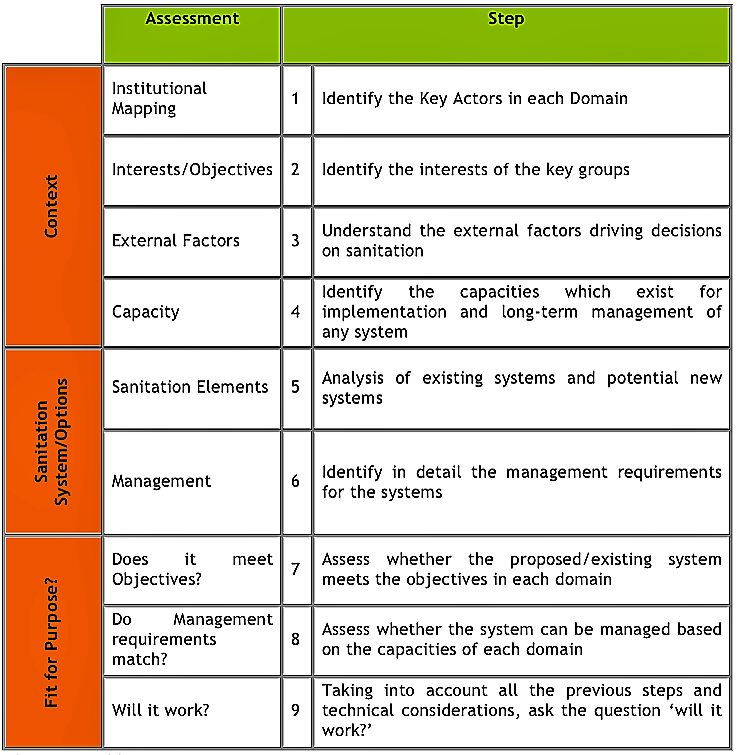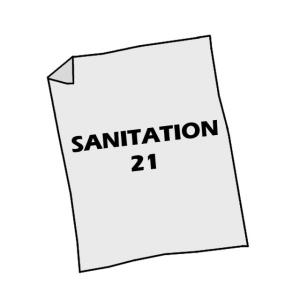Executive Summary
The framework proposed by the International Water Association (IWA) task force for the analysis and selection of appropriate sanitation systems is called Sanitation 21. It is a comprehensive approach for the assessment of planned or existing sanitation situations. However, it does not provide in-depth guidance for planners and operators. The Sanitation 21 task force argues that technical planners and designers have to develop more sophisticated planning systems that respond to the needs of rapidly growing cities. As regards the human and political context, this will require a change in the manner of making technical decisions. Quality and effectiveness of sanitation investments are not particularly about technologies (although the appropriate application of technology is important), but are rather about developing an explicit understanding of what the objectives of a system are and then designing a system which meets those objectives (IWA 2005).
Basic Understanding
Whilst the Sanitation 21 planning framework is not a new planning approach (its principles are collected from the corpus of planning work that precedes it), it does motivate a new mindset amongst technical planners and those with responsibility for urban sanitation. In particular, it seeks to open a debate and encourage the technical professional community to think beyond ‘business as usual’ approaches, appealing to strong business arguments of efficiency and effectiveness in design as the way to bring about positive change (SuSanA 2008).
Sanitation 21 consists of three parts to effective sanitation planning:
- defining the context
- identifying technical options
- determining the feasibility of the options
These three phases are broken into nine action steps (Table 1). The analysis of the context recognises that different domains exist within a city and that the stakeholders in each of these domains will have different objectives with regards to sanitation. The domains can be understood as household, neighbourhood, district, city, and beyond city. The context within each domain will include a set of interests, external drivers, and management capacity that are identified through a participatory process with the stakeholders.
During the second step, a range of technical options is identified and listed according to their treatment capacity and level of management required. At this stage, a generic list of sanitation system types can be used that include both on-site and centralised systems. The purpose here is more to look at the functionality, operation, maintenance, and basic management requirement of the systems than to outline specific costs and design requirements.
The key and third step in the framework is finally to select a technology based on its ability to meet the objectives defined by the stakeholders. At this stage the important questions are to determine if the management requirements match the community capacity, basically if the system will work. It is important to realise that it is possible to apply different technical options at different domains within the city in order to adequately meet the needs and institutional realities of everyone (NETSSAF 2008).

The message of Sanitation 21 is: Improving the quality and effectiveness of sanitation investments is not particularly about technologies (although the appropriate application of technology is important); rather, it is about developing an explicit understanding of what the objectives of a system are and then designing a system which meets those objectives. The Sanitation 21 Task Force argues that technical planners and designers have to get smarter at planning systems which respond to the needs of the modern city. This requires a sea change in the way technical decisions are taken, so that they can respond better to the human and political context in which they are made (IWA 2005).
Subscribe here to the new Sanitation and Water Entrepreneurship Pact (SWEP) newsletter. SWEP is a network of organizations joining hands to help entrepreneurs design and develop lasting water and sanitation businesses.
Sanitation 21 is a planning approach used for sustainable sanitation planning in urban and peri-urban areas of the developing world. The main focus of the approach affects the understanding of technical planners and designers with an existing planning experience to rethink their idea of a useful planning design. The approach is thus better applicable for people who are already in a planning process for urban sanitation. It can be seen as an assessment tool for urban sanitation planning.
Sanitation 21
Sanitation 21 presents an internationally recognized planning framework based upon key principles of sanitation planning and recommended process guidelines. Built upon practical experience and best practices, Sanitation 21 brings together decisions about technology and management options with stakeholder needs and preferences to help inform the choice of appropriate sanitation systems. It is written in non-technical language to be relevant to policy makers and practitioners who are interested in providing appropriate and affordable sanitation services and presents recommended activities to guide the development of a city sanitation plan. This revised version of the Sanitation 21 framework builds upon the increase in knowledge and experience in city-wide planning.
PARKINSON, J. LUETHI, C. WALTHER, D. IWA ; GIZ ; Eawag-Sandec (2014): Sanitation 21. A Planning Framework for Improving City-wide Sanitation Services. London: International Water Association (IWA) URL [Accessed: 16.06.2019]Sanitation 21. Simple Approaches to Complex Sanitation. A Draft Framework for Analysis
This document reflects the framework of Sanitation 21 very detailed. Hence, it explains the single parts of the framework comprehensible.
IWA (2005): Sanitation 21. Simple Approaches to Complex Sanitation. A Draft Framework for Analysis . London: International Water Association IWA. URL [Accessed: 16.06.2019]Introduction to the NETSSAF Participatory Planning Approach, a tutorial and guideline for sustainable sanitation planning
This presentation describes the NETSSAF participatory planning approach in a brief manner.
BARRETO DILLON, L. BUZIE FRU, C. (2008): Introduction to the NETSSAF Participatory Planning Approach, a tutorial and guideline for sustainable sanitation planning . (= Proceedings of the NETSSAF Final Conference “Pathways towards Sustainable Sanitation in Africa" ). Ouagadougou (Burkina Faso): Network for the development of Sustainable Approaches for large scale implementation of Sanitation in Africa (NETSSAF) URL [Accessed: 18.07.2019] PDFPlanning for Sustainable Sanitation
This factsheet deals with the planning of sustainable sanitation for urban and peri-urban areas of the developing world and its importance for increased sanitation coverage by 2015.
SUSANA (2008): Planning for Sustainable Sanitation. (= SuSanA Fact Sheet ). Eschborn: Sustainable Sanitation Alliance URL [Accessed: 14.02.2010]Sanitation 21
Sanitation 21 presents an internationally recognized planning framework based upon key principles of sanitation planning and recommended process guidelines. Built upon practical experience and best practices, Sanitation 21 brings together decisions about technology and management options with stakeholder needs and preferences to help inform the choice of appropriate sanitation systems. It is written in non-technical language to be relevant to policy makers and practitioners who are interested in providing appropriate and affordable sanitation services and presents recommended activities to guide the development of a city sanitation plan. This revised version of the Sanitation 21 framework builds upon the increase in knowledge and experience in city-wide planning.
PARKINSON, J. LUETHI, C. WALTHER, D. IWA ; GIZ ; Eawag-Sandec (2014): Sanitation 21. A Planning Framework for Improving City-wide Sanitation Services. London: International Water Association (IWA) URL [Accessed: 16.06.2019]Sanitation 21. Simple Approaches to Complex Sanitation. A Draft Framework for Analysis
This document reflects the framework of Sanitation 21 very detailed. Hence, it explains the single parts of the framework comprehensible.
IWA (2005): Sanitation 21. Simple Approaches to Complex Sanitation. A Draft Framework for Analysis . London: International Water Association IWA. URL [Accessed: 16.06.2019]The Vienna Charter on Urban Sanitation
The purpose of this charter is to consolidate best practice in effective and sustainable urban sanitation as it has been developed in several communities of practice into a single coherent unifying set of guiding principles.
IWA (2008): The Vienna Charter on Urban Sanitation. London: International Water Association IWA. [Accessed: 17.04.2012] PDFThe NETSSAF Participatory Planning Approach
This document presents an overview of some existing participatory sanitation planning tools, illustrating the scope of the steps and some of the common methodologies employed in the various frameworks.
NETSSAF (2008): The NETSSAF Participatory Planning Approach. South Africa: Network for the Development of Sustainable Approaches for Large Scale Implementation of Sanitation in Africa. [Accessed: 10.02.2010] PDFHygiene and Sanitation Software. An Overview of Approaches
In sanitation and hygiene programme and service delivery, several methods are used to engage target groups in development programmes to enable behavioural change and/or create a demand for services. These methods or approaches are generally referred to as ‘software’, to distinguish them from the provision of ‚hardware‘. This publication takes an in-depth look at the various hygiene and sanitation software approaches that have been deployed over the last 40 years in all types of settings – urban, informal-urban and rural, and aims to address such issues as what a particular approach is designed to achieve, what it actually comprises, when and where it should be used, how it should be implemented and how much it costs, etc.
PEAL, A. EVANS, B. VAN DER WOORDEN, C. (2010): Hygiene and Sanitation Software. An Overview of Approaches. Geneva: Water Supply & Sanitation Collaborative Council (WSSCC) URL [Accessed: 16.06.2019]Review of Frameworks for Technology Assessment
A WASHTech literature review of existing frameworks for technology assessment reveals that there is a gap for a WASH technology assessment tool and a WASH technology uptake tool. The authors of the review, which supports the development of WASHTech’s Technology Assessment Framework, (TAF), conclude that a computer tool based on an algorithm is not appropriate because it is too rigid. Choosing a manageable number of appropriate indicators is key for assessing new technologies.
OLSCHEWSKI, A. DANERT, K. FUREY, S. KLINGEL, F. (2011): Review of Frameworks for Technology Assessment. WASHTech Deliverable 3.1. St. Gallenand The Hague : Swiss Centre for Development Cooperation in Technology and Management (SKAT) and International Water and Sanitation Centre (IRC) URL [Accessed: 26.05.2019]Planning for Sustainable Sanitation
This factsheet deals with the planning of sustainable sanitation for urban and peri-urban areas of the developing world and its importance for increased sanitation coverage by 2015.
SUSANA (2008): Planning for Sustainable Sanitation. (= SuSanA Fact Sheet ). Eschborn: Sustainable Sanitation Alliance URL [Accessed: 14.02.2010]Planning Tools
This Sustainable Sanitation Practice (SSP) issue contains the following contributions: 1. Better Design Planning Tools, 2. Tackling Complex Urban Sanitation Problems, 3. The SSWM Toolbox, 4. Comparing Economic Costs of Sanitation
MUELLEGGER, E. ; LANGEGRABER, G. ; LECHNER, M. (2011): Planning Tools. (= Sustainable Sanitation Practice , 7 ). Vienna: Ecosan Club URL [Accessed: 01.07.2013]Introduction to the NETSSAF participatory planning approach - A tutorial and guideline for sustainable sanitation planning
The NETSSAF tutorial for sustainable sanitation planning introduces a participatory planning approach. It targets planners of sanitation programmes in West Africa and provides guidance in facilitating “informed choices” in consultation with users and other stakeholders.
Sustainable Sanitation Alliance (SuSanA)
The official website of the Sustainable Sanitation Alliance SuSanA. SuSanA is a loose network of a number of organizations active in the field of sanitation, founded in 2007. The goals and objectives of SuSanA are to contribute to the achievement of the MDGs, to raise awareness on what sustainable sanitation solutions are and to promote them on a larger scale. The website contains a number of factsheets by the different SuSanA working groups on various subjects related to sustainable sanitation. There is section where everyone can upload important documents.


